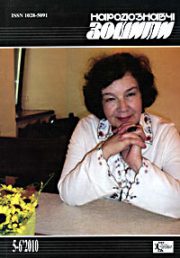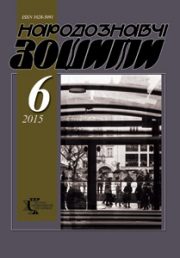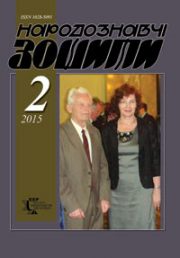The Ethnology Notebooks. 2023. № 1 (169), 120—125
UDK 930.2:[[39:728](=161.2):[72.04:745.51]](477.43-22)”18/19″
DOI https://doi.org/10.15407/nz2023.01.120
DISCOVERY OF A PLANK WITH CARVING FROM S.SURZHА, KHMELNYTSKYI REGION
NECHYTAILO Pavlo
- ORCID ID: https://orcid.org/0000-0002-6849-2705
- Candidate of Historical Sciences, Doctor of Philosophy,
- Senior Researcher,
- State Enterprise «Research Center «Protective Archaeological Service»
- of the Institute of Archeology of NASU»
- Kamianets-Podilskyi, Ukraine,
- Contacts: e-mail: kparchaeology@gmail.com
NAKONECHNA (HOSHCHITSKA) Tetiana
- ORCID ID: https://orcid.org/0000-0001-8596-8974
- Candidate of Historical Sciences, Doctor of Philosophy,
- Researcher Fellow
- of department of Historical Ethnology of the Institute
- of Ethnology The National Academy
- of Sciences of Ukraine,
- 15, Svoboda Ave., 79000, Lviv, Ukraine,
- Contacts: e-mail: hoshchitska.tetiana@gmail.com
Abstract. Introduction: Folk construction is an extremely interesting and diverse component of the traditional culture of Ukrainians. Despite undergoing constant improvement, folk architecture also preserved many archaic features over the centuries. Problem Statement: Despite the significant research potential, it must be stated that the study of the specifics of the tradition of housing construction of some ethnographic regions is insufficient. Among them, in particular, there is the traditional architecture of Podillia, which was marked by the existence of a significant variety of construction techniques, methods and materials, which, however, have not been brought into the research focus. The object of the given article is the constructive elements of Podillia housing of the ethnographic period, the subject is a board with carvings found during the dismantling of a window frame in a house of the 19th — the first half of the 20th century, from the village of Surzha, Kamianets-Podilskyi district, Khmelnytskyi region. Purpose: The scientific novelty is that the researched beam with a carved image of a cross and several Cyrillic inscriptions was interpreted by us as a svolok (the main beam, under the ceiling in a wooden structure, in an old Ukrainian house, which was usually located along the longitudinal axis) that was reused in a new dwelling. Мethods: We used methods of analysis and synthesis, comparative methods, methods of field research and interdisciplinary methods. Conclusion: In the case of a svolok fragment found in the village of Surzha, we most likely see an example of reusing an old svolok in a new house. However, here it was turned into a window frame. This is certainly an interesting ethnographic case, some aspects of which still require additional research. Above all, this concerns the reading and interpretation of the inscriptions (the working version proposed by Timur Bobrovsky is now perceived as the most likely), as well as more accurate dating of the find.
Keywords: beam, forms of crosses, folk architecture, carving, Podillia.
Received 6.01.2023
REFERENCES
- Kosmina, T.V. (1973). Local features of public housing in the southern regions of Podillia. Folk creativity and ethnography, 4, 24—31 [in Ukrainian].
- Kosmina, T.V. (1980). Village housing of Podillia. The end of the 19th and 20th centuries. Historical and ethnographic research. Kyiv: Naukova dumka [in Ukrainian].
- Kosmina, T. (1994). Ethnic expressiveness of public housing. In: Podillia Historical and ethnographic research (Pр. 236—243). Kyiv: Naukova dumka [in Ukrainian].
- Danyliuk, A.H. (1987). Podilsk house. Science and society, 7, 73—75 [in Ukrainian].
- Danyliuk, A.H., & Bodrevych-Buts’, O.M. (1980). The use of stone in the folk construction of Podillia. Folk creativity and ethnography, 1, 85—88 [in Ukrainian].
- Danyliuk, A.H. (1993). Traditional housing and economic construction in western Podillya. In: Podilsk antiquity (Pр. 395—400). Vinnytsia [in Ukrainian].
- Radovych, R. (1996). Rural housing of the late 19th and early 20th centuries in the south of Podillia (according to the materials of the Borshchiv district). In Chronicle of Borshchivshchyna: historical and local history collection (Vol. 8, pp. 58—66). Borschiv [in Ukrainian].
- Radovych, R. (2010). Traditional housing of Ukrainians of southern Podillia in the second half of the 19th and early 20th centuries: constructive and technological aspect (based on materials from the Khmelnytskyi region). In: Bulletin of Lviv National University named of I. Franko. The series is historical (Vol. 45, pp. 437—462) [in Ukrainian].
- Sauliak, B.M. (2018). The development of woodworking crafts of Eastern Podillia at the end of the 19th and the beginning of the 21st centuries. Kyiv: Naukova dumka [in Ukrainian].
- Sapozhnykov, I.V., Sliusar, Yu.O., & Shuvalov, O.R. (1995). Typology of stone gravestone crosses of South-Western Ukraine. In: Antiquities of the Black Sea Region (Vol. 2, pp. 16—47). Odesa [in Ukrainian].
- Zhvava, O. (2009). Vocabulary of the funeral rite in the dialects of the Transnistrian-Bukovyna-Podilskyi confederation. In: Studia methodologica (Vol. 27, pp. 35—140). Ternopil: Editorial publishing department of TNPU named after V. Hnatyuk [in Ukrainian].
- Uzeneva, E.S. (1995). Girder. Slavic antiquities: Ethno linguistic dictionary (Vol. 3, рр. 201—203). Moscow: Mezhdunarodnyye otnosheniya [in Russian].
- Hrebin’, I.F. (1994). Ceremonies are associated with the construction of rural housing. In: Podillia: historical and ethnographic study (Pp. 243—250). Kyiv: Naukova dumka [in Ukrainian].
- Dovhan’, S.O. (2009). Podilsk housing in the system of customs and ceremonies. In: Scientific notes of Vinnytsia State Pedagogical University named after Mykhailo Kotsyubynskyi. Series: history (Vol. 15, рр. 178—183). Vinnytsia [in Ukrainian].
- Siletskyy, R. (2011). Тraditional bulding rites of Ukraine. Lviv: LNU of I. Franko [in Ukrainian].
- Shkira, M.V., Shkira, N.M., & Shkira, L.M. (2008). Carved bastards in a traditional folk dwelling (based on the materials of the artifacts of the Museum of Folk Architecture and Life of the Central Dnipro region of the Pereyaslav National Historical and Ethnographic Reserve). In: Sivershchyna in the history of Ukraine. Collection of scientific papers (Vol. 11, рр. 420—427). Kyiv; Glukhiv [in Ukrainian].
- Yatsenko, S.P. (2010). Bastard from the collection of the Zaporizhye Museum of Local History. Museum Bulletin, 10, 9—15 [in Ukrainian].






